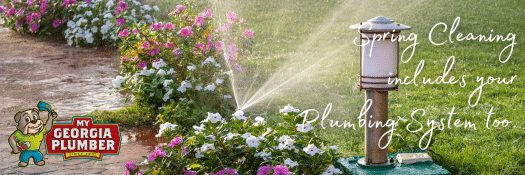
Spring Plumbing Maintenance Tips
Spring is synonymous with Spring Cleaning! From indoors to outdoors there are chores to be done to keep your home in pristine condition and functioning smoothly. Your plumbing is no different. Let’s explore some spring plumbing maintenance tips.
Indoor Plumbing Chores:
- Perform Water Heater Maintenance: Ensure your water heater functions optimally by conducting regular maintenance. Drain the tank every six months, particularly during spring and fall, to eliminate sediment buildup. Turn off the power source, close the water supply valve, attach a hose to the drain valve, and drain the tank either outside or into a designated container. Consider calling My Georgia Plumber to flush your water heater so that you can rest assured that it’s done effectively.
- Verify for Leaks: With winter’s thaw, it’s crucial to check for hidden leaks that may have developed in your plumbing system. Conduct a meter test by shutting off all water sources and observing the flow gauge. Even minor movement indicates a leak, necessitating immediate attention to prevent water wastage and potential damage.
- Check Toilet for Leaks: Toilets are common sources of unnoticed leaks, leading to increased water bills and potential damage. Perform a dye test by adding color dye to the tank and monitoring for any color seepage into the bowl. Address issues such as continuous running or phantom flushing promptly to conserve water and maintain toilet efficiency.
Outdoor Plumbing Chores:
- Inspect Outdoor Faucets: Inspect your outdoor faucets for damage or leaks before spring use. Remove winter covers and ensure no hoses are attached, as they could have caused vulnerability to freezing. Address any drips or leaks promptly to prevent water wastage and potential outdoor damage.
- Check for Outdoor Pipe Leaks: Survey your yard for wet or soggy areas, indicating possible leaks in pipes leading from the meter to your house. Addressing outdoor leaks promptly can prevent water waste, landscape damage, and potential structural issues.
- Clear Outdoor Drains, Gutters, and Downspouts: Remove accumulated debris from outdoor drains, gutters, and downspouts to prevent clogs and ensure proper water drainage. Clearing these areas reduces the risk of water damage to your home’s foundation and helps maintain efficient plumbing systems.
- Exercise Water Supply Valves: Prevent plumbing emergencies by periodically exercising water supply valves. Turn them off and on to prevent them from becoming stiff and unusable. This ensures that you can quickly shut off water flow to specific fixtures or areas of your home in case of leaks, overflows, or repairs.
Call My Georgia Plumber!
For comprehensive plumbing maintenance and repair services, trust My Georgia Plumber. Our experienced team is dedicated to ensuring the efficiency and reliability of your plumbing system, both indoors and outdoors. Don’t hesitate to contact us for professional assistance with all your plumbing needs. Enjoy a worry-free spring season with My Georgia Plumber by your side!











